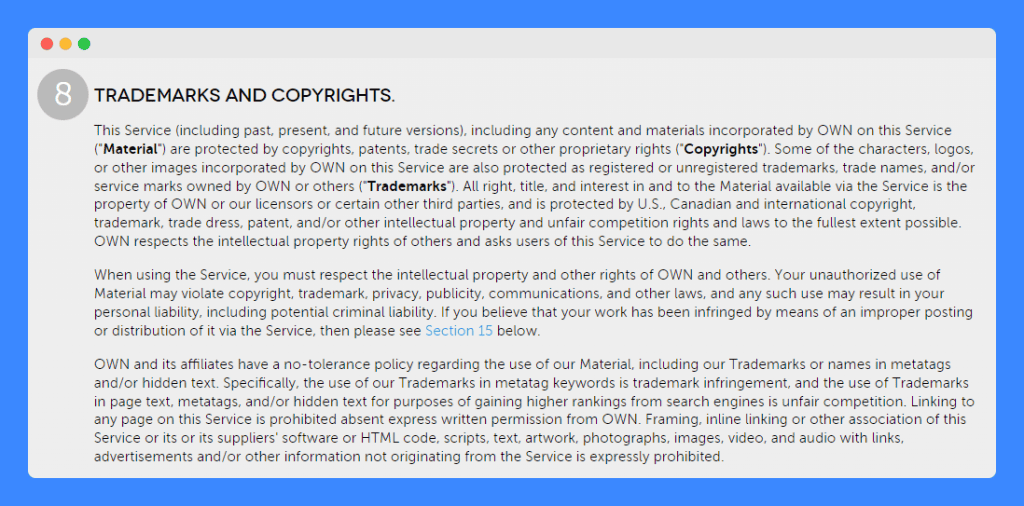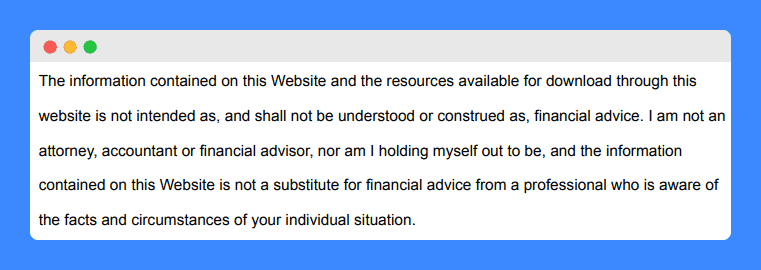Running an online business or website requires wearing many hats. You’re a content creator, product or service provider, and sometimes even an advisor.
With so much information flying around, protecting yourself and your business becomes crucial. That’s where a disclaimer comes in. But what is a disclaimer, really?
A website disclaimer is a statement or notice on a website aiming to limit the liability of the site’s owners regarding the information and services provided. It usually clarifies that the content is for informational purposes only, and it’s not responsible for any inaccuracies, errors, or omissions.
While disclaimers may seem like boring legalese, a well-written one can be a valuable tool that benefits both you and your audience.
But for one to effectively safeguard your business, you should understand more than just the meaning of the disclaimer. Below, I’ll talk about its importance, what information it typically contains, and how you can create one for your website.
- A website disclaimer is a notice limiting the owner’s liability for site content, stressing informational use, and not professional advice.
- Use a disclaimer when your site deals with sensitive topics, offers downloadable content, allows user interaction, or provides any kind of advice.
- While tempting, writing your own disclaimer is not recommended. Disclaimers involve legal complexities, and an improperly worded one could expose you to liability.
Table of Contents
PRO TIP: Take the hassle of writing your own disclaimer away with our disclaimer generator trusted by over 200,000 businesses. It’ll save you hours of work and possible costly legal mistakes.
Why Do You Need a Disclaimer for Your Business?
You need a disclaimer because it protects your business from liability by ensuring that visitors are aware of the limitations of the content you provide.
It becomes even more important if your website handles confidential information or provides advice that could be interpreted as professional guidance.
In these cases, a disclaimer can clearly communicate that the information presented is for informational purposes only and shouldn’t be solely relied upon for critical decisions.
Still confused? Here are specific reasons why having a disclaimer is important for websites:
It Protects Your Rights
A disclaimer states that others cannot use your intellectual property without your permission. That said, it’s important to note that disclaimers have limitations.
It can’t single-handedly prevent copyright infringement, but it does play a role in protecting your intellectual property. This is particularly crucial if your work is literary or artistic, as the disclaimer can assert your copyright ownership.
Here’s an example of that in action:

For other intellectual property forms, such as technical solutions, you need to obtain a patent for full protection. Similarly, to secure ownership of words, phrases, symbols, and designs associated with your brand (like logos or slogans), registering a trademark is advisable.
It Limits Your Liabilities
A disclaimer acts as a safeguard, limiting your business’s liability for damages arising from your website’s content.
By including a disclaimer, you essentially inform visitors that your business will not be held responsible for something if they choose to act on the information presented. This helps manage expectations and protects you from potential lawsuits.
The disclaimer can also clarify your obligations to your readers, as in:

By outlining your qualifications or background, you can set boundaries regarding the scope of your advice or expertise. This is particularly helpful if your website delves into areas where you might not be a certified professional.
It Disclaims Third-Party Liability
A disclaimer serves as an assertion that disclaims responsibility for third-party interactions (e.g., comments, advertisements, and testimonials) on your website, blog, or social media pages.
It clarifies that the views expressed in the examples do not represent your business’s stance, as in:

By including such a disclaimer, you can safeguard your business from being held liable for the actions or opinions of others who interact with your online presence. This protection helps maintain your business’s integrity and avoid potential legal issues.
It Protects the Organization or Company to Which You Belong
While a disclaimer cannot fully shield you from liability, such as in cases of negligence or legal non-compliance, it plays a crucial role in protecting your business.
For instance, it helps exclude legal responsibility for personal opinions, clarifying that they do not represent the opinion of the organization or company to which you have an affiliation.
This is particularly important if your website or blog is associated with a larger entity, as it helps protect both you and the organization from potential harm. Here’s an example of that:

By clearly stating the boundaries of your views and responsibilities, it serves as a preventive measure against misunderstandings and legal issues.
When Do You Need a Disclaimer for Your Business?
Your business needs a disclaimer whenever you provide content, advice, or services that could potentially lead to misunderstandings, misuse, or legal claims.
If you’re still unsure when to use a disclaimer, here are some key situations where it can be particularly useful:
- When your website deals with sensitive topics: If your website covers areas like finance, health, or legal matters, a disclaimer can help mitigate liability for any unforeseen consequences arising from following your advice.
- When your website offers downloadable content: Disclaimers can be helpful for downloadable content like templates or ebooks. They help clarify that you are not responsible for any errors or issues that may arise from using them.
- When your website allows user interaction: If your website allows comments, forums, or social media integration, a disclaimer can protect you from liability associated with third-party content.
- When you aren’t a certified professional: If your website offers advice in a field where you lack formal qualifications, a disclaimer can manage expectations and clarify that the information provided is for general guidance only.
Any business owner would benefit from asking the question, “When do I need a disclaimer on my website?”
Even seemingly innocuous content can benefit from a disclaimer. For instance, if your website offers instructions on a DIY project, a disclaimer can help protect you from liability in case someone gets injured while following your instructions.
Similarly, if your website features blog posts with travel recommendations, a disclaimer can clarify that you are not responsible for any negative experiences that may arise during the trip.
If your website offers any information or advice that could potentially lead to loss or damage (including death or personal injury), it’s best to have a disclaimer in place.
10 Key Components of a Disclaimer
By now, you should already be familiar with the disclaimer on websites. However, to ensure that it effectively addresses the unique needs and legal considerations of your business, you must understand its key components.
What should a disclaimer include? The answer may vary depending on the nature of your online presence and the risks associated with it. Generally, it’s important to include the following elements in a standard disclaimer:

1. Scope of Information
This section is like a friendly reminder that the content on the website is there to inform and enlighten, not to replace expert advice. It’s a way to set expectations and ensure that visitors understand the purpose and limitations of the information provided.
2. Limitation of Liability
In this clause, you’re essentially telling your site visitors, “We’ve put in a lot of effort to provide valuable information, but we’re not perfect. If there are any mistakes or something’s missing, we’re not responsible for any issues that might cause you.”
Basically, it’s a way to protect your online business from legal headaches if things don’t go as planned.
3. Intellectual Property Rights
This part is like putting a “No Trespassing” sign on your content. It tells visitors that you own the creative stuff on your site, like articles or images, and sets rules for how they can use or share it. It’s your way of keeping your digital property safe.
PRO TIP: Use clear, specific language to outline your intellectual property rights and consider registering your trademarks or copyrights for added protection. Regularly monitor your content for unauthorized use and take action when necessary.
4. External Links
Think of this section as a friendly heads-up to your visitors. This is the part where you tell them that when they click on links that take them away from your site, they’re stepping into someone else’s territory.
By letting them know you can’t vouch for what they’ll find there or how those sites operate, you’re protecting your business from being held accountable for any unexpected issues they might encounter on those external sites.
5. User Responsibility
By including a user responsibility clause in your disclaimer, you shift some of the onus to your website visitors. This clarifies that users who voluntarily access your website take responsibility for how they interpret and utilize the information presented.
This protects your business from liability if someone misinterprets or misuses the information on your site. However, disclaimers have limitations, and you may still be held responsible for inaccurate or misleading information.
6. Governing Law
A governing law clause within your disclaimer specifies the jurisdiction and legal system that applies in case of any disputes arising from your website’s use. It helps ensure all legal matters are handled accordingly, potentially streamlining any resolution process.
Imagine your website is like a digital storefront. Just like physical stores operate under specific laws depending on their location, your website also needs to follow a defined legal framework.
For instance, if your business is located in California, you might state that your disclaimer and website use are governed by the laws of the State of California, United States.
7. Contact Information
Including a contact information clause in your disclaimer serves a dual purpose. Firstly, it demonstrates transparency. By providing an easy way to reach you, you show openness to questions or concerns they might have about the disclaimer or the information on your site.
This transparency is crucial, as a 2022 survey revealed that 60% of consumers from various countries across the globe believed that trustworthiness and transparency were the most important traits of a brand.
Secondly, it establishes a communication channel. If a user has questions about the limitations of the information or the disclaimer itself, they can easily reach out for clarification.
8. Affiliate and Endorsement Disclaimer
As an online business owner, you might partner with other companies or feature products you recommend. An affiliate and endorsement disclaimer clause ensures transparency in these situations, which is crucial for maintaining trust.
As Salesforce.com CEO, Mark Benioff, aptly points out:
“Companies that don’t value trust as a top priority are going to have trouble keeping their customers moving forward.”
By disclosing any affiliate relationships or paid endorsements, you’re not only adhering to legal and ethical standards but also reinforcing your commitment to transparency.
PRO TIP: Even if you don’t have any formal affiliate partnerships, it’s still a good idea to clarify that you have no affiliation with the company. This way, your audience can make informed decisions based on your recommendations.
9. Health and Financial Disclaimers
Websites that delve into sensitive areas like health or finances require a more specific approach to disclaimers. If yours do, consider including a dedicated health and financial disclaimer clause.
This clause should clearly state that the information provided, while intended to be helpful, may include general advice only and should not be solely relied upon for making important health or financial decisions.
10. Changes to the Disclaimer
The online world is constantly evolving, and so is the information you provide on your website. Informing users about these changes can be done through a simple sentence added to the disclaimer itself.
Simply state that you reserve the right to modify the disclaimer at any time and that continued use of the website constitutes acceptance of the updated terms.
How To Enforce a Disclaimer
Enforcing a disclaimer relies on the user’s acceptance of its terms. By continuing to use the website after encountering a disclaimer saying they are not liable for certain actions, users are acknowledging their understanding and agreement.
For instance, if you are sued because the information on your site was inaccurate and caused someone harm as a result, you may be able to point to the disclaimer in court as a way of protecting yourself against liability.
This argument may or may not be compelling to the judge, but this is how you would use a disclaimer in the “real world.” You can make your case stronger by making sure of two things:
Make Sure Your Terms Are Fair
To make a disclaimer legally binding, you must ensure that its terms are fair to your clients or customers. That said, there are some things that a disclaimer cannot shield you from.
For one, you cannot disclaim liability for negligence or include terms that are contrary to law. You must also make sure that there are no vague terms that might mislead your clients or customers.
Make Your Customers Aware of Your Disclaimer
Your disclaimer should be placed where it is easily seen by your readers. They shouldn’t have to struggle trying to find it.
Generally speaking, a disclaimer is not something that you will need to actively enforce. Rather, it is in place to potentially protect you in case legal action is taken against your website.
How Do You Create a Disclaimer for Your Business?
Knowing the essential components of a disclaimer is crucial, but how do you translate that knowledge into actually crafting one?
There are several approaches you can consider if you want to learn how to write a disclaimer for websites. Each one has its own advantages and limitations.
1. Hire a Lawyer
A lawyer can assess your website’s unique features and risks, and then craft a disclaimer that perfectly addresses your needs. They can also answer any questions you have and offer legal advice on best practices.
The downside? Their expertise comes at a cost. This route can be the most expensive, with fees depending on your website’s complexity and the lawyer’s experience.
2. Use a Generator
A disclaimer generator offers solid protection without breaking the bank. It will guide you through the process of creating disclaimers with clear questions and fill-in-the-blank templates.
Sure, it might not be as custom-made as a lawyer-drafted disclaimer, but for most websites, it provides more than enough protection. Plus, you can save time and avoid the legal jargon headache.
The key is finding a good disclaimer generator that offers customizable options and covers a wide range of legal scenarios. Ensure it provides clear explanations for each section and allows you to tailor the disclaimer to your specific needs.
3. Use a Template
Templates can get you going quickly, especially if you find one geared towards your website’s niche. They can provide a solid framework to build upon and ensure you’re covering the essential legal areas.
However, there’s a catch. Firstly, the accuracy of the information in the template may not be perfect, and it may contain generic language that doesn’t fully address the specific risks of your website.
Secondly, templates might not be designed for your intended audience or the type of content you offer. For instance, a template for an e-commerce website might not be suitable for a blog offering financial advice.
4. Write It Yourself (Not Recommended)
Writing a disclaimer yourself, without legal expertise, is risky. While you can browse through examples for inspiration, crafting a legally sound disclaimer requires precise language and an understanding of legal implications.
Without a legal editor, you may overlook critical aspects, leaving your business vulnerable. It’s generally not recommended unless you have a solid grasp of legal requirements.
Frequently Asked Questions
Are disclaimers legally binding?
Disclaimers can be legally binding if they are prominently displayed and agreed to by the user. However, their enforceability can vary based on jurisdiction and the specific circumstances of the case.
Why should you use a disclaimer?
Using a disclaimer protects your business from liability by informing users of the limitations of your goods or services, reducing the risk of legal claims.
Where can you display your disclaimer on your website?
When deciding where to put a disclaimer on website, consider placing it in the footer, on key pages, or during the checkout process for maximum visibility and legal coverage.
Can you copy a disclaimer from another website?
No. Copying a disclaimer from another website is not recommended as it may not suit your specific needs and could lead to legal issues.
Can you use a disclaimer template?
You can use a disclaimer template, but it may not fully suit your needs. Templates might not cover all aspects of your business, potentially leaving you exposed to risks.
Is a disclaimer the same as terms and conditions?
When you look at the answer to what is a website disclaimer, it’s obvious that it’s different from terms and conditions. A disclaimer limits liability, while T&Cs set out rules for using a website.
Do disclaimers need to be updated regularly?
Yes, disclaimers should be updated regularly to reflect changes in your business, laws, or website practices. This ensures they remain accurate and legally effective.
Are there different types of disclaimers?
Yes, there are various types of disclaimers, such as website disclaimers, email disclaimers, and disclaimers in advertisements. Each serves to limit liability in specific contexts.



